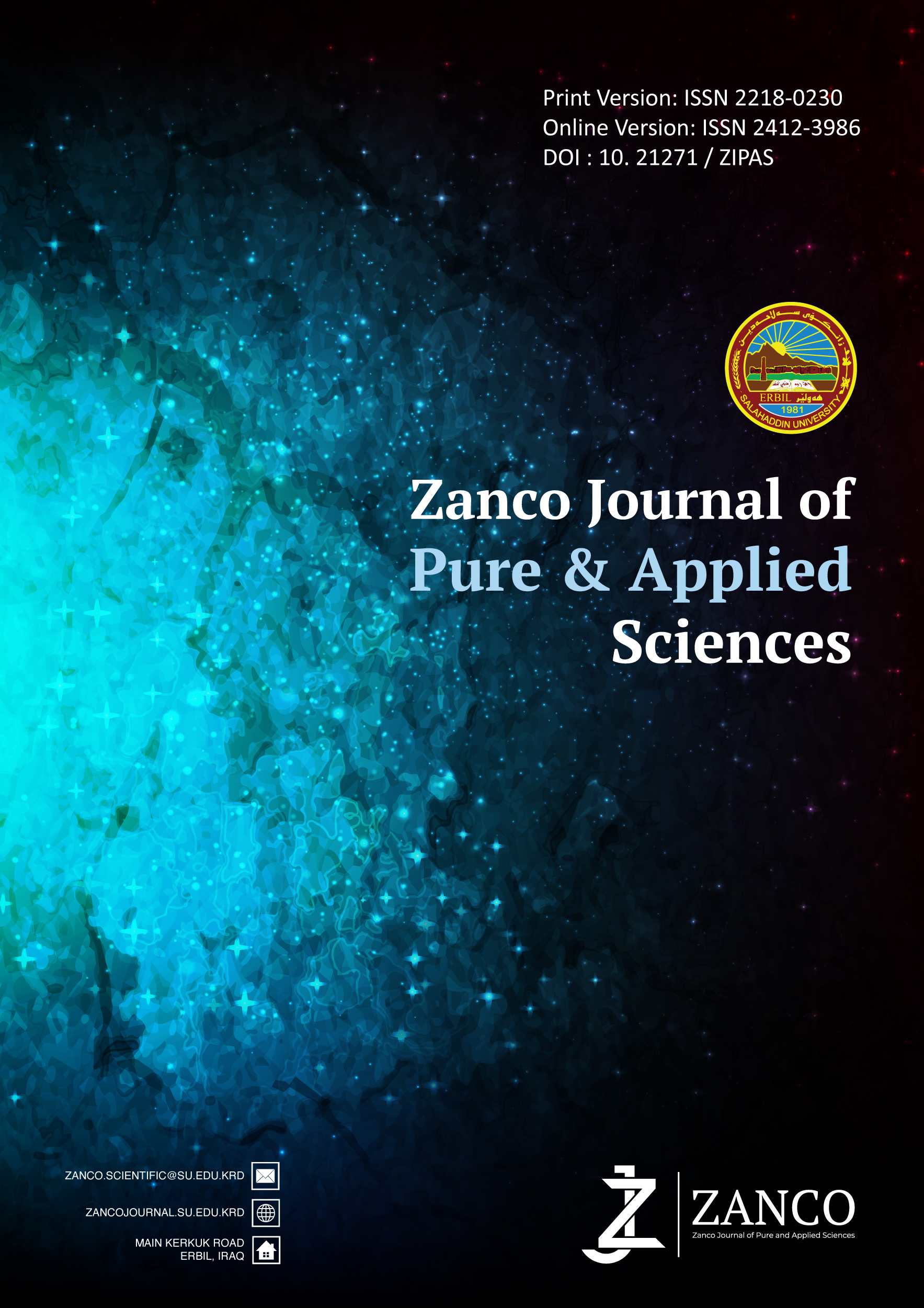Three-dimensional Modeling of the Interaction of a Bubble pair with a Rigid Wall using Boundary Integral Method
DOI:
https://doi.org/10.21271/ZJPAS.36.6.6Keywords:
Boundary integral method; Three-dimensional; Local smoothing; Pressure, Bubble pair.Abstract
This study examines the three-dimensional dynamics of two gas bubbles near a horizontal rigid wall, focusing on how inter-bubble distance affects their shape, size, and jet formation. The Boundary Integral Method (BIM) with a novel local smoothing technique is employed. Critical parameters including jet velocity, bubble centroid movement, bubble radius, and collapse time are computed for each bubble to understand their interaction dynamics comprehensively. The velocity vector field and pressure distribution surrounding the bubbles are analyzed, providing detailed insights into the fluid dynamics. The findings demonstrate that inter-bubble distance significantly influences their interaction and overall behavior. These results advance the understanding of bubble dynamics near rigid boundaries, with potential applications across various scientific and engineering disciplines.
References
Aziz, I. A., Manmi, K. M., Saeed, R. K. & Dadvand, A. 2019. Modeling three dimensional gas bubble dynamics between two curved rigid plates using boundary integral method. Engineering Analysis with Boundary Elements, 109, 19-31.
Choi, K., Kim, S., Kim, H. & Kim, C. Influence of the non-isothermal phase change on cavitation bubble dynamics. AIAA SCITECH 2024 Forum, 2024. 2190.
Church, C. C. 1995. The effects of an elastic solid surface layer on the radial pulsations of gas bubbles. The Journal of the Acoustical Society of America, 97, 1510-1521.
Deane, G. B. & Stokes, M. D. 2002. Scale dependence of bubble creation mechanisms in breaking waves. Nature, 418, 839-844.
Deen, N. G., Van Sint Annaland, M. & Kuipers, J. 2004. Multi-scale modeling of dispersed gas–liquid two-phase flow. Chemical Engineering Science, 59, 1853-1861.
Dong, C.-S. & Wang, G.-Z. 2005. Curvatures estimation on triangular mesh. Journal of Zhejiang University-Science A, 6, 128-136.
Duffy, D. G. 2015. Green's functions with applications, Chapman and Hall/CRC.
Ferrara, K., Pollard, R. & Borden, M. 2007. Ultrasound microbubble contrast agents: fundamentals and application to gene and drug delivery. Annu. Rev. Biomed. Eng., 9, 415-447.
Han, R., Zhang, A., Li, S. & Zong, Z. 2018. Experimental and numerical study of the effects of a wall on the coalescence and collapse of bubble pairs. Physics of Fluids, 30.
Jund, A. A., Dadvand, A., Aziz, I. A. & Manmi, K. M. 2024. An extended Laplacian smoothing for boundary element analysis of 3D bubble dynamics. Engineering Analysis with Boundary Elements, 160, 76-88.
Katsikadelis, J. T. 2016. The boundary element method for engineers and scientists: theory and applications, Academic Press.
Li, Z.-R., Sun, L., Zong, Z. & Dong, J. 2012. A boundary element method for the simulation of non-spherical bubbles and their interactions near a free surface. Acta Mechanica Sinica, 28, 51-65.
Rypl, D. & Nerad, J. 2016. Volume preserving smoothing of triangular isotropic three-dimensional surface meshes. Advances in Engineering Software, 101, 3-26.
Saleki-Haselghoubi, N., Dadvand, A., Rasouli, S. & Kadivar, E. 2024. Droplet generation by the oscillation of two spark-generated bubbles near a confined opening. Engineering Analysis with Boundary Elements, 159, 213-228.
Tanizawa, K. 1995. A nonlinear simulation method of 3-D body motions in waves. Journal of the Society of Naval Architects of Japan, 178, 96-105.
Tsouris, C. & Tavlarides, L. 1994. Breakage and coalescence models for drops in turbulent dispersions. AIChE Journal, 40, 395-406.
Wang, C. & Khoo, B. 2004. An indirect boundary element method for three-dimensional explosion bubbles. Journal of Computational Physics, 194, 451-480.
Wang, C., Khoo, B. & Yeo, K. 2003. Elastic mesh technique for 3D BIM simulation with an application to underwater explosion bubble dynamics. Computers & Fluids, 32, 1195-1212.
Wang, L., Zhang, Y.-F., Li, H., Sui, Y.-G., Wu, K., Zhang, D.-M. & Yao, W.-H. 2024. Theoretical and numerical studies of the coupled Bjerknes and buoyancy effects on the dynamics of an underwater explosion bubble near a free surface. Ocean Engineering, 297, 117101.
Wang, Q. & Manmi, K. 2014. Three dimensional microbubble dynamics near a wall subject to high intensity ultrasound. Physics of Fluids, 26.
Wang, Q., Manmi, K. & Calvisi, M. L. 2015. Numerical modeling of the 3D dynamics of ultrasound contrast agent microbubbles using the boundary integral method. Physics of Fluids, 27.
Wang, X., Wu, G., Zheng, X., Du, X. & Zhang, Y. 2022. Theoretical investigation and experimental support for the cavitation bubble dynamics near a spherical particle based on Weiss theorem and Kelvin impulse. Ultrasonics Sonochemistry, 89, 106130.
Wu, G. 1998. Hydrodynamic force on a rigid body during impact with liquid. Journal of Fluids and Structures, 12, 549-559.
Xi, W. Q. 2004. Numerical simulation of violent bubble motion. Physics of Fluids, 16, 1610-1619.
Yang, X., Liu, C., Hu, Y., Zhao, M. & Hu, C. 2024. Shock wave induced by the collapse of a bubble cluster with each bubble distributed randomly. Ocean Engineering, 300, 117362.
Yao, X.-L., Zhang, A.-M. & Liu, Y.-C. 2007. Interaction of two three-dimensional explosion bubbles. Journal of Marine Science and Application, 6, 12-18.
Ye, X., Yao, X. & Han, R. 2015. Dynamics of cavitation bubbles in acoustic field near the rigid wall. Ocean Engineering, 109, 507-516.
Zhang, A. & Ni, B. 2014. Three-dimensional boundary integral simulations of motion and deformation of bubbles with viscous effects. Computers & Fluids, 92, 22-33.
Zhang, A. & Xiong-Liang, Y. 2008. The interaction between multiple bubbles and the free surface. Chinese Physics B, 17, 927.
Downloads
Published
How to Cite
Issue
Section
License
Copyright (c) 2024 Imad A. Aziz

This work is licensed under a Creative Commons Attribution 4.0 International License.














